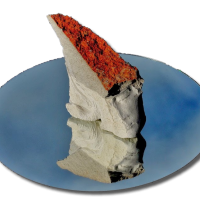






Posted in Exhibitions, Featured

In the creation of art it is determined and develops awareness of own cultural identity, selected by cultural self-determination within which is running permanent searching for meaning.
Dear art enthusiasts
“… For behold, the winter is past.
The flowers have already appeared in the land,
The time has arrived for pruning the vines,
And the voice of the turtledove has been heard in our land.
The fig tree has ripened its figs,
And the vines in blossom have given forth their fragrance …“
Šir ha-Širim, Asma Asmaton, Canticum Canticorum, The Song of Songs,
Hohelied, Visoka pesem, Pjesma nad pjesmama, Kanat vrhu svih kanti.
This evening we are starting this speech with Biblical verses to draw
attention to the work of the two twin souls one more time, whose art aims
at justifying everything that is and everything that is worth. This was for
ages the aim followed by the best thinkers (and today I do not say artists
on purpose, because there are more and more of non-thinkers) with
their one goal, which is to reveal to the very fact of life, its explanation, to
draw attention to the meaning, to the secret of its very source, and to the
sacrament of the inflow of life.
Giving value to life has always been the task of art, and in making an
opinion of these values there are benchmarks for cultural viability. /A
person-artist becomes civilised when (s)he introduces (new) values in
his/her life, when (s)he sets tasks to himself/herself and aims to achieve
them. By realising them, we form our own self as well as other’s being,
we become better and more valuable, making the world more valuable
too. Artistic creation determines and develops the awareness of our own
cultural identity, our cultural self-determination within which the eternal
quest for meaning goes on. During this process even the artist could turn
from a cultural subject into a cultural object, which is the major trap in the
art today, becoming an end to itself, with no source and no inflow. With
Nejašmić-Pirnat and Pirnat-Nejašmić the goal is crystal clear.
Therefore, we are here to greet the two artists tonight, first of all
sculptors in their own self-determination, who are not slaves to sculptural
techniques, but they understand art primarily as a part of their own
yet general cultural self-determination as well. It is equally valuable to
create drawings, graphic arts, paintings, and sculptures or organise an
atelier, a gallery, exhibitions, and meetings with other artists. This social,
sociological approach to artistic creation is the new value with which
to shape the aforementioned cultural identity of the individual and the
community, for us with still unforeseeable consequences.
Their unity is like fine linen in which it is difficult to tell who is weft, and
who warp. In weaving there are two systems of threads: warp is the
lengthwise or longitudinal thread, while weft is the transverse thread.
When they overlap, they actually crisscross, in this case it is sculptural,
artistic weaving, whose weft and warp form a cross, and the cross is
love, love is truth, truth is desire and pursuit and hope for love; but not
without the cross, and so we spin in a circle. In the holy mystical circle of
life around the cross which, surprisingly, they are not ashamed to profess
Not only do they profess it, but they preach it in their own way, rejoicing
in God’s gift of procreation, of creating together and gladly sharing with
others.
In this light it is not important whether the joy of sharing is happening
somewhere in European cultural centres where they both exhibited and
proved their quality, or here in the tiny gallery of St Anthony at Postira.
It is important that they always and everywhere remind us of personally
experienced and consciously accepted cultural identity resting on a
deckchair woven in numerous crosses. This is their warp, this is their
weft, their artistic foundation bathed in the whiteness of depicted doves,
which we are going to strengthen tonight with the miraculous verses
from Šir ha-Širim, Asma Asmaton, Canticum Canticorum, The Song of
Songs, Hohelied, Visoka pesem, Pjesma nad pjesmama, Kanat vrhu svih
kanti:
“Arise, my love, my fair one, and come away
O my dove, in the clefts of the rock,
In the secret places of the cliff,
Let me see your face and hear your voice,
For your voice Is sweet,
And thy countenance is comely.”
And the best of all is that they both believe that not one of the created
doves can fly, not a single creature on earth, not one act, particularly an
act of artistic creation, happens without a puff of the wind of Holy Spirit.
Let the exhibition tonight be rest for the tired, breeze in the heat,
conversation of the sad, to the joy of all united people of good will.
Professor Branko Matulić, PhD